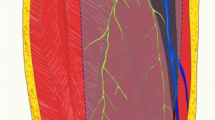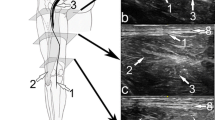Abstract
Neuropathy of the posterior femoral cutaneous nerve may manifest as pain and paresthesia in the skin over the inferior buttocks, posterior thigh, and popliteal region. Current treatment options include physical and oral pain therapy, perineural injections, and surgical neurectomy. Perineural steroid injections may provide short-term pain relief; however, to our knowledge, there is currently no minimally invasive denervation procedure for sustained pain relief that could serve as an alternative to surgical neurectomy. Percutaneous cryoablation of nerves is a minimally invasive technique that induces a sustained nerve conduction block through temporary freezing of the neural layers. It can result in long-lasting pain relief, but has not been described for the treatment of neuropathy-mediated PFCN pain. We report a technique of MR-guided cryoablation of the posterior femoral cutaneous nerve resulting in successful treatment of PFCN-mediated sitting pain. Cryoablation of the posterior femoral cutaneous nerve seems a promising, minimally invasive treatment option that deserves further investigation.



Similar content being viewed by others
References
Tubbs RS, Miller J, Loukas M, Shoja MM, Shokouhi G, Cohen-Gadol AA. Surgical and anatomical landmarks for the perineal branch of the posterior femoral cutaneous nerve: implications in perineal pain syndromes. laboratory investigation. J Neurosurg. 2009;111(2):332–5.
Fritz J, Bizzell C, Kathuria S, Flammang AJ, Williams EH, Belzberg AJ, et al. High-resolution magnetic resonance-guided posterior femoral cutaneous nerve blocks. Skeletal Radiol. 2013;42(4):579–86.
Dellon AL. Pain with sitting related to injury of the posterior femoral cutaneous nerve. Microsurgery. 2015;35(6):463–8.
Trescot AM. Cryoanalgesia in interventional pain management. Pain Physician. 2003;6(3):345–60.
Filler AG, Haynes J, Jordan SE, Prager J, Villablanca JP, Farahani K, et al. Sciatica of nondisc origin and piriformis syndrome: diagnosis by magnetic resonance neurography and interventional magnetic resonance imaging with outcome study of resulting treatment. J Neurosurg Spine. 2005;2(2):99–115.
Fritz J, Chhabra A, Wang KC, Carrino JA. Magnetic resonance neurography-guided nerve blocks for the diagnosis and treatment of chronic pelvic pain syndrome. Neuroimaging Clin N Am. 2014;24(1):211–34.
Fritz J, Dellon AL, Williams EH, Belzberg AJ, Carrino JA. 3-Tesla high-field magnetic resonance neurography for guiding nerve blocks and its role in pain management. Magn Reson Imaging Clin N Am. 2015;23(4):533–45.
Chua NH, Vissers KC, Sluijter ME. Pulsed radiofrequency treatment in interventional pain management: mechanisms and potential indications-a review. Acta Neurochir (Wien). 2011;153(4):763–71.
Diederich CJ. Thermal ablation and high-temperature thermal therapy: overview of technology and clinical implementation. Int J Hyperthermia. 2005;21(8):745–53.
Savastano LE, Laurito SR, Fitt MR, Rasmussen JA, Gonzalez Polo V, Patterson SI. Sciatic nerve injury: a simple and subtle model for investigating many aspects of nervous system damage and recovery. J Neurosci Methods. 2014;227:166–80.
Alaqeel A, Alshomer F. High resolution ultrasound in the evaluation and management of traumatic peripheral nerve injuries: review of the literature. Oman Med J. 2014;29(5):314–9.
Rosen A, Tardast A, Shi TJ. How far have we come in the field of nerve regeneration after trigeminal nerve injury? Curr Oral Health Rep. 2016;3(4):309–13.
Campos NA, Chiles JH, Plunkett AR. Ultrasound-guided cryoablation of genitofemoral nerve for chronic inguinal pain. Pain Physician. 2009;12(6):997–1000.
Koethe Y, Mannes AJ, Wood BJ. Image-guided nerve cryoablation for post-thoracotomy pain syndrome. Cardiovasc Intervent Radiol. 2014;37(3):843–6.
Byas-Smith MG, Gulati A. Ultrasound-guided intercostal nerve cryoablation. Anesth Analg. 2006;103(4):1033–5.
Stolzenberg D, Gordin V, Vorobeychik Y. Incidence of neuropathic pain after cooled radiofrequency ablation of sacral lateral branch nerves. Pain Med. 2014;15(11):1857–60.
Author information
Authors and Affiliations
Corresponding author
Ethics declarations
The data of this case report were obtained under an internal review board-approved protocol for prospective data collection and with informed consent.
Conflicts of interest
The authors declare that they have no conflicts of interest.
Rights and permissions
About this article
Cite this article
Joshi, D.H., Thawait, G.K., Del Grande, F. et al. MRI-guided cryoablation of the posterior femoral cutaneous nerve for the treatment of neuropathy-mediated sitting pain. Skeletal Radiol 46, 983–987 (2017). https://doi.org/10.1007/s00256-017-2617-6
Received:
Revised:
Accepted:
Published:
Issue Date:
DOI: https://doi.org/10.1007/s00256-017-2617-6




